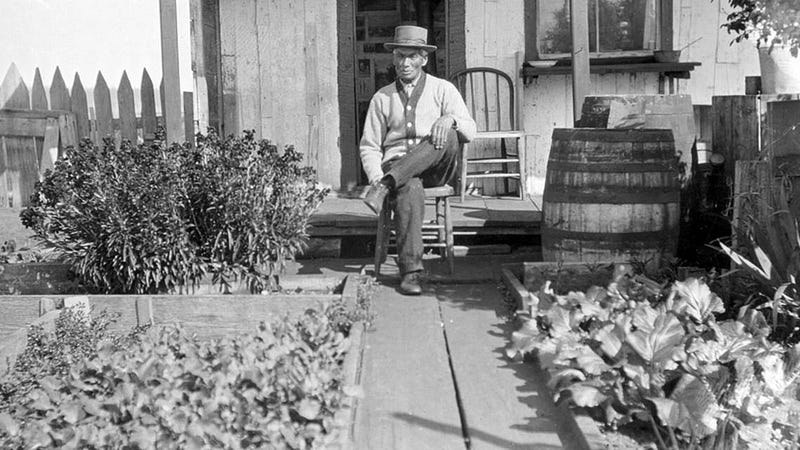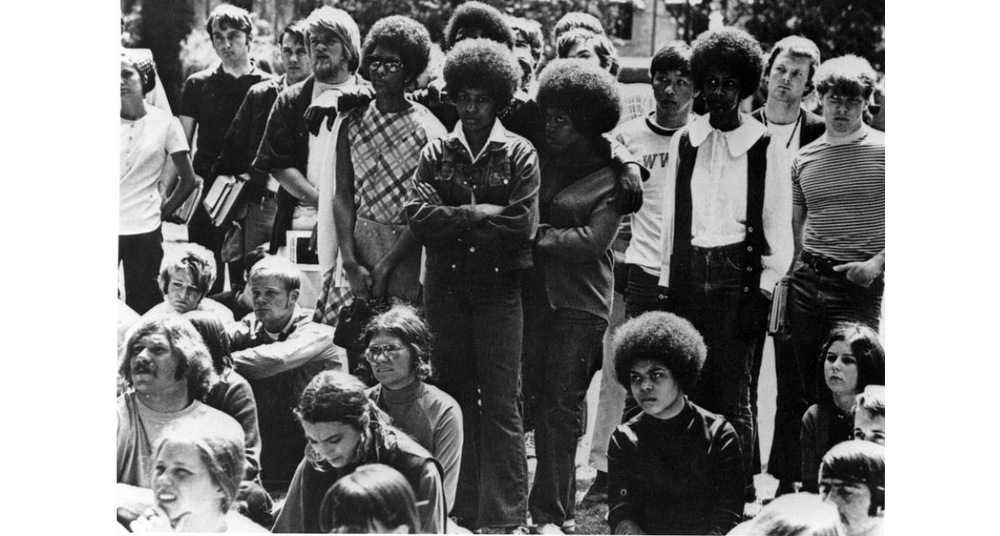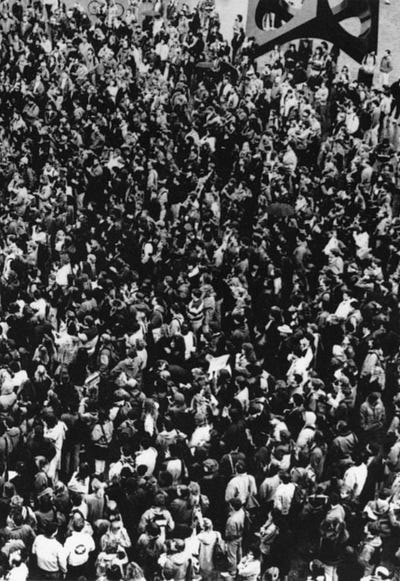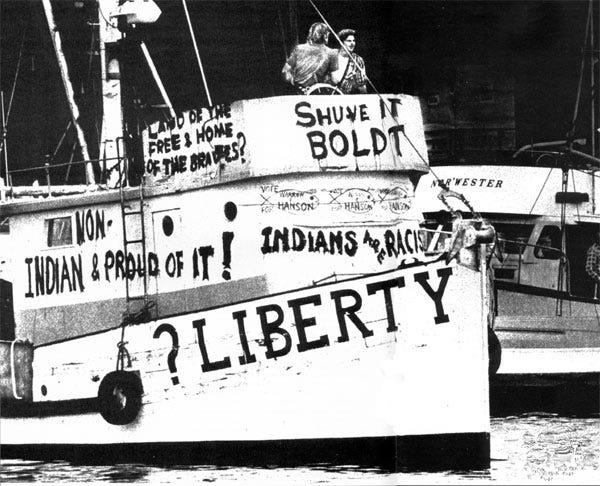The Far-Right of the Upper Left
Whatcom County’s violent white supremacist past and present, and the prospect of deradicalization
Story by Riley Currie
White supremacy has a long history in the Pacific Northwest, from the European incursions of the 1700s to modern far-right flyers and presence at protests. As the Black Lives Matter movement gains momentum in Whatcom County, hate groups are becoming more prominent, but so is the idea of deradicalizing their members.

Local community activist Stacy Bloch always refers to his cousin, who is alive and well in another part of the state, in the past tense.
“Growing up, I thought he was one of the coolest guys in the world,” Bloch said. “He was one of the fun cousins, he was always fun to hang out with.” His cousin’s family was religious, but never extremely so. In the 70s, Bloch said, he was a hippie. Eventually, he joined the military and became a paratrooper.
Years later, when Bloch became friends with his cousin on Facebook, there was a disconnect. His cousin started questioning some of Bloch’s posts about activism and human rights causes.
“I started seeing these, ‘the liberals are coming for you,’ or, ‘get them before they get you,’ posts from him,” Bloch said. “One post was about clearing the brush around your house so you have better sight lines, so you can shoot people approaching your house.”
Eventually the jokes crossed a line. Bloch’s interactions with his cousin stopped being friendly political banter and started to become upsetting.
“I started teasing him,” Bloch said. “But it stopped being funny. I’m thinking, ‘hang on, you want to shoot me?’”
Bloch believes that his cousin didn’t get his far-right belief system from his family. His other cousins have expressed that they “don’t know what happened” to cause this shift in his cousin’s thinking.
“It’s really disappointing,” Bloch added. “Here’s one of the coolest people in the world, and then all of a sudden they turn out to be pretty extreme and pretty darn ugly in the way that they think.” He and his cousin are not on speaking terms.
Bloch’s interest in activism was piqued in his early teens, during the protests against the Vietnam War. He became even more involved in activist causes in the 1980s, when he protested the Central American wars and advocated for the antinuclear movement. He’s currently a well-known cannabis and human rights activist in Bellingham.
Bloch is the first generation of his family since they emigrated from Germany in the 1880s to not grow up on a farm in North Dakota. His father, a World War II veteran, was born in the United States to German immigrants. His father’s role in the war and hatred of the Nazi party fascinated Bloch, and he has always been interested in “fringe-y” hate groups.
“Oregon and Washington in particular have really heavy racist histories,” Bloch said. Hate group activity in the Pacific Northwest is nothing new. In 2019, 30 hate groups were tracked in Washington state, according to the Southern Poverty Law Center. The Ku Klux Klan, one of the United States’ most infamous white nationalist groups, made its first appearance in Bellingham in the 1920s.
“When you think about the Klan, you think the Deep South,” Bloch said. “You don’t think Bellingham, Railroad and Holly.”
Whatcom County is 86.2% white, according to the U.S. Census Bureau’s 2019 estimate. That’s almost 10% more white than the United States. (Bellingham falls squarely in the middle, at 82.5% white.) Bellingham also has a long history as a hotspot for white supremacy.
“White supremacy is really built into the fabric of our country,” said Miri Cypers, regional director of the Anti-Defamation League’s Pacific Northwest Office. “There’s certainly this white nationalistic ideology that envisions especially the Pacific Northwest as a bastion for whiteness.”
Many of the same elements that appealed to white settlers in the 18th and 19th centuries appeal to white supremacist and white separatist groups today.
“[White supremacist groups] just don’t see a place for people of color, Jews, immigrants and other marginalized groups as even being a part of this country or society,” Cypers said.
She notes that the Anti-Defamation League has seen a surge in reports of hate groups present at protests of all kinds since 2016. Whatcom County is no exception.
In early June, several concerned residents filed reports of individuals armed with AR-15 assault rifles at peaceful protests in downtown Bellingham. Stephan Hadeen, who self-identified as one of the armed individuals, went live on the air for an interview with Joe Teehan on KGMI NewsTalk 790 on June 5. Hadeen is a member of the Washington Three Percent.
The Three Percent define themselves as “a national organization made up of patriotic citizens who love their country, their freedoms, and their liberty.” The Anti-Defamation League defines the Three Percent as a “wing of the militia movement that arose as part of a resurgence of the militia movement in 2009.”
When asked why guns were present at the protest, Hadeen said that they “didn’t need a reason.”
Ben Scholtz, owner of Mallard Ice Cream, posted on Facebook on June 7, adding his voice in opposition to the presence of firearms in downtown Bellingham.
Scholtz went on to say that he believes in the Second Amendment and understands that Washington is an open-carry state, but “that doesn’t mean we can’t state our safety concerns as individuals, a community, and a neighborhood.”
“While running a business for 20 plus years, I have never seen a single instance that would have been improved by a private citizen having a firearm in Bellingham. On the contrary, the open-carry of firearms (especially semi-automatic rifles) adds a significant concern for the people who live, work, and shop here,” Scholtz continued.


On July 5, the Young Activists of Whatcom County organized a march for Black Lives in Lynden, Washington. The Lynden Freedom group was also in attendance, with trucks, American flags and guns in tow. Police stood between the protesters and Lynden Freedom group at several points along the march.
“Those who brought out assault weapons in front of children peacefully protesting should be ashamed,” said Whatcom County Councilmember Rud Browne. “Simply ashamed.”
Browne, originally from Australia, has lived in Whatcom County for 25 years and is a U.S. citizen.
“When I walk around, if I keep my mouth shut, most people don’t know I’m an immigrant,” he said. Browne retains a strong Australian accent. While, as a white man, he doesn’t have any lived experience being discriminated against on the basis of his race, he does have experience being discriminated against for his immigrant status. He’s often told to “go back to where he came from.”
Like most white people, Browne says, he knows he sees only a small percentage of the discrimination that occurs in his neighborhood or county. His focus now is on awareness.
“The center of the population has become more aware,” he said. “But the extreme end of the population has also become more emboldened.”
Stacy Bloch has seen the same trend.
“What’s bubbling to the surface right now is driven by fear and hate,” Bloch said. “They’re afraid of losing what they’ve grown up with or what they’ve been accustomed to.”
Those involved in far-right or white supremacist groups are primarily afraid of losing their privilege, Bloch added. He described a banner he saw with the phrase “equal rights for indigenous whites” emblazoned on it.

Historically ignorant and cruel sentiments like that one have been circulating in Whatcom County for decades, but there’s been an uptick in recent years. In 2019, the hate group Patriot Front plastered Ferndale and the border of the Lummi nation with flyers that read, “not stolen, conquered.”
Bloch believes the current presidential administration has given space for many of these fringe hate groups to express themselves more publicly. President Trump infamously said of the deadly protests in Charlottesville, Virginia in August of 2017 that there were “very fine people, on both sides.”
Bloch believes things will get worse before they get better. He worries about the possibility of “some sort of spasm of violence on the way out” on behalf of some of these hate groups.
Bloch is excited, however, about the future and direction of the Black Lives Matter movement in Whatcom County.
“Many times, you think you’re going to get really close to seeing some real social justice and equality, you end up being disappointed,” Bloch said. “But this may be the first time in all my decades of being involved in something, fighting for some form of justice, this movement may be it.”
Many also argue for a deradicalization approach. Life After Hate is a nonprofit devoted to helping individuals exit the violent far-right. Founded in 2011, the nonprofit conducts a wide variety of education, intervention, academic research, and outreach.
“The most important thing to remember is that hateful ideology is not a prerequisite for joining a hate group,” said Dimitrios Kalantzis, director of communications at Life After Hate. According to Kalantzis, many people are sucked into extremism when a basic human need for connection is “hijacked.”
“Trauma, shame, and identity issues are common themes,” Kalantzis added. “People use violent far-right extremism to make sense of their place in the world.” Those feeling isolated may lean into conspiracy theories and violent stances on immigration.
When it comes to helping someone leave the violent far-right, Kalantzis said that, as dissatisfying an answer as it may be, the most important thing is to exercise patience, and to remind that person that they are loved and welcome.
Many people who come to Life After Hate have already decided that they want to change, so the nonprofit focuses on giving them a positive community and support. According to Kalantzis, individuals are more likely to leave a hate group if they feel they have a community that is waiting for them.
“Radicalization isn’t linear,” Kalantzis said. “So neither is deradicalization. It’s often a lifelong process.”
Kalantzis also emphasized the importance of raising awareness, not only of hate groups, but of institutional forms of white supremacy. There’s a tendency to associate hate groups with rural, isolated areas.
“To call hate groups a naturally occurring phenomenon in certain geographical regions is to absolve the rest of the country from a racism that millions of people are living in and facing every day,” Kalantzis said. “Every day, we make decisions that are rooted in white supremacy. If we don’t ask ourselves, ‘what decisions am I making that are informed by white supremacy,’ aren’t we complicit?”
Stacy Bloch has been following these issues closely for years, and continues to confront them regularly in his own community. He knows that as a white activist in Bellingham, it’s easier for him to speak out than it is for many others. For Bloch, deradicalization and rehabilitation are excellent ideas, but hard to envision clearly.
“A lot of these people have a lot of hate inside them,” Bloch said. “I don’t know if all of them can change. But if you can show them that the things they’re afraid of aren’t going to happen, then maybe they can change … good grief, we can only hope.”
